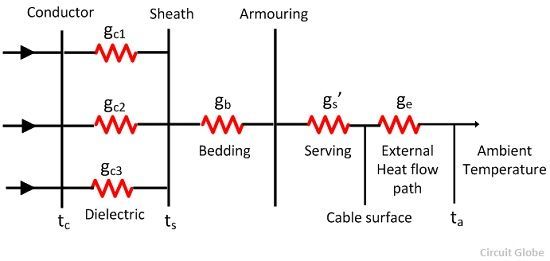Max Operating Current to Max Continuous Current
Definition: The current rating of the cable is defined as the maximum current carrying capacity of the power cable under normal operating condition. The current rating of power cable decided the upper limit of power transfer by a cable. It mostly depends on the insulation temperature and electrical resistance of the conductor. The cable rating is classified under three headings. These are
- Normal maximum continuous current rating.
- Over-current rating
- Short- Circuit rating
Classifications of Current Rating of Cable
The different types of current rating of cables are explained below in details.
Normal or Safe Current Carrying Capacity
The normal or safe current carrying capacity depends on some factors. Some of the important factor are : the minimum conductor operating temperature, heat dissipating properties of the cables and condition of installation.
For calculating the current-carrying capacity of the cable, the thermal resistivities of the sheath and cable are neglected. The heat generated in the cable is due to various losses is conducted to the air or ground through various paths. These paths offer various resistance to the flow of heat.
In the three phase cable, all the three conductors are at the same temperature. The heat produced flows outwards through the dielectric in three parallel paths from the conductor to the sheaths. The thermal resistances between the core and the sheath may be assumed to be gc1, gc2, and gc3. It then passes through the bedding of resistance gb, metallic armouring serving of resistance g's. Finally, it passes into surrounding air or ground depending upon the method of installation of cable.
 Let the thermal resistance of the external heat flow path be ge, i.e., ge is the thermal resistance between the outer surface of the cable and ambient.The thermal resistance of metallic portion namely screens, sheath, and armouring are negligible. Heat is generated due to the loss in the core.
Let the thermal resistance of the external heat flow path be ge, i.e., ge is the thermal resistance between the outer surface of the cable and ambient.The thermal resistance of metallic portion namely screens, sheath, and armouring are negligible. Heat is generated due to the loss in the core.
 Where θ = temperature difference between maximum permissible temperature and ambient and
Where θ = temperature difference between maximum permissible temperature and ambient and
![]() The maximum current rating is, therefore, given by,
The maximum current rating is, therefore, given by,
 where Rθ = AC resistance per unit length of the conductor at the maximum operating temperature including allowance for skin and proximity effects.
where Rθ = AC resistance per unit length of the conductor at the maximum operating temperature including allowance for skin and proximity effects.
n = number of loaded conductor in the cable
gd = thermal resistance of the dielectric
gb = thermal resistance of the bedding between sheath and armouring
g's = thermal resistance of serving
ge = thermal resistance between the outer surface of the cable and ambient
λ = sheath loss factor, i.e., the fractional increment in a.c. the resistance of the conductor to allow for sheath loss
Over Current Rating
The over current rating rating rating depends on the thermal conditions of the cable. The value of maximum continuous current ratings of cables is supplied by manufacturers.The rating valid for the specified conditions of installation (depth of laying, ground temperature, air temperature, etc.)
Short Circuit Rating
In short circuit conditions, the current flows through the cables are many times the full load value of the current. The heat produced in the conductor is proportional to the square of the current. The duration of a short circuit is very small. The temperature gain under short circuit conditions is greater than the maximum permissible temperature for continuous rating.
The short circuit rating of the cable depends on upon the maximum current attained by the cable under short circuit condition. The safe value of limiting temperature is usually taken as 120°C, for a maximum continuous operating conductor temperature of 80ºC and the permissible temperature rise of 50ºC. The short current is measured by the formula
 Isc = short-circuit RMS current
Isc = short-circuit RMS current
A = cross – sectional area of conductor
t = duration of short circuit current
k = a constant
The value of current depends on the rise of temperature
Source: https://circuitglobe.com/current-rating-of-cable.html
0 Response to "Max Operating Current to Max Continuous Current"
Postar um comentário